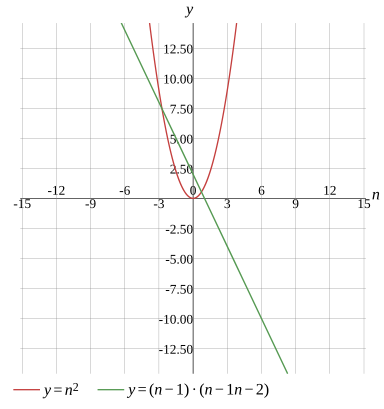Question
Solve the quadratic equation
Solve using the quadratic formula
Solve by completing the square
Solve using the PQ formula
n1=−1−3,n2=−1+3
Alternative Form
n1≈−2.732051,n2≈0.732051
Evaluate
n2=(n−1)(n−1×n−2)
Simplify
More Steps


Evaluate
(n−1)(n−1×n−2)
Multiply the terms
(n−1)(n−n−2)
Subtract the terms
More Steps


Evaluate
n−n−2
The sum of two opposites equals 0
0−2
Remove 0
−2
(n−1)(−2)
Multiply the terms
−2(n−1)
n2=−2(n−1)
Expand the expression
More Steps


Evaluate
−2(n−1)
Apply the distributive property
−2n−(−2×1)
Any expression multiplied by 1 remains the same
−2n−(−2)
If a negative sign or a subtraction symbol appears outside parentheses, remove the parentheses and change the sign of every term within the parentheses
−2n+2
n2=−2n+2
Move the expression to the left side
n2+2n−2=0
Substitute a=1,b=2 and c=−2 into the quadratic formula n=2a−b±b2−4ac
n=2−2±22−4(−2)
Simplify the expression
More Steps


Evaluate
22−4(−2)
Multiply the numbers
More Steps


Evaluate
4(−2)
Multiplying or dividing an odd number of negative terms equals a negative
−4×2
Multiply the numbers
−8
22−(−8)
If a negative sign or a subtraction symbol appears outside parentheses, remove the parentheses and change the sign of every term within the parentheses
22+8
Evaluate the power
4+8
Add the numbers
12
n=2−2±12
Simplify the radical expression
More Steps


Evaluate
12
Write the expression as a product where the root of one of the factors can be evaluated
4×3
Write the number in exponential form with the base of 2
22×3
The root of a product is equal to the product of the roots of each factor
22×3
Reduce the index of the radical and exponent with 2
23
n=2−2±23
Separate the equation into 2 possible cases
n=2−2+23n=2−2−23
Simplify the expression
More Steps


Evaluate
n=2−2+23
Divide the terms
More Steps


Evaluate
2−2+23
Rewrite the expression
22(−1+3)
Reduce the fraction
−1+3
n=−1+3
n=−1+3n=2−2−23
Simplify the expression
More Steps


Evaluate
n=2−2−23
Divide the terms
More Steps


Evaluate
2−2−23
Rewrite the expression
22(−1−3)
Reduce the fraction
−1−3
n=−1−3
n=−1+3n=−1−3
Solution
n1=−1−3,n2=−1+3
Alternative Form
n1≈−2.732051,n2≈0.732051
Show Solution

Graph
